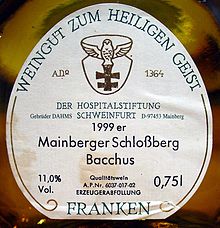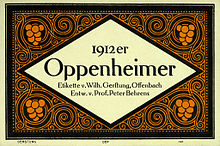Wine label
The wine label provides the consumer with information about the purchase of wine . Every wine container with a volume of less than 60 liters must be labeled.
Information
The labeling law for wine regulates in detail the content and sometimes also formal criteria (such as font size) of the information on the label. Basically, the principle applies that only information that is expressly permitted may be placed on the label; Some are mandatory, others are optional:
Mandatory information
These must be easily legible on the label in the same viewing area.
- Quality level
- for example quality wine , country wine
- Geographical origin
- The indication of the geographical origin is partly mandatory, partly optional. That depends on the quality level and how detailed the geographical indication is.
- Bottler
- The details of the bottler must also include the place where the bottler is based. Under certain circumstances, the bottler information can be coded with a code number.
- Alcohol content
- The actual alcohol content must be given in the unit volume percent .
- Nominal volume
- denotes the volume of the wine bottle .
- Lot identification
- to identify the wine; In the case of quality wine, the lot number is replaced by the
- Official exam number
- This number identifies the wine in terms of quality wine testing .
- Contains sulphites
- This information has been mandatory since 2006 if the wine was sulphurized during production.
- Casein, ovalbumin
- If wines are fined with the protein-containing fining agents casein or ovalbumin and are sold in the EU after June 30, 2012, this must be stated on the wine label. There is a transition period for existing wine stocks.
Information to be used optionally
The most important optional information to be used are:
- Vintage that means the year in which the grapes for the wine were grown and usually also harvested. May only be indicated on the label if at least 85% of the vines have been harvested that year.
- Grape variety for example Riesling . The grape variety from which at least 85% of the wine was pressed can be specified. It is also possible to specify two grape varieties, but then the wine must consist of 100% of these grape varieties.
- Indication of taste The terms "dry", "semi-dry", "sweet" or "sweet" are permitted.
- Wine location and location, this describes the exact origin of the wine, for example "Assmannshäuser Höllenberg".
- Additional information such as drinking temperatures or food recommendations have been permitted since 2007.
history
Forerunners of today's wine label existed about 6000 years ago with the Sumerians , who put cylinder seals on their vessels , which contained information about the wine they contained. The Greeks and Romans replaced the cylinder seal with a small tag that was hung on the amphora , or the information was simply scratched into the amphora. These pieces of paper were still in use in the Middle Ages. The first wine labels, as we know them today, only appeared with lithography , which made it possible to produce small quantities of labels at a reasonable cost. The first known wine label with a picture was used for an 1822 FM Schloss Johannisberger Cabinets wine and represented the castle with the surrounding vineyards.
At the beginning of the 20th century, the Graphic Institute W. Gerstung specialized in the printing of wine labels. The designers were hired directly by the print shop, including personalities such as Peter Behrens , Richard Throll and Ludwig Enders .
Web links
- German wine law
- Annotated information on wine law, especially information on wine labels (PDF; 1.3 MB)
- Château Mouton Rothschild: The artist's wine labels
- Information for wine label collectors

